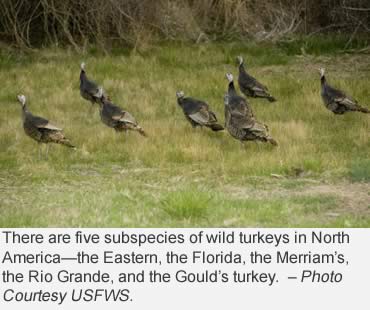Benjamin Franklin called the wild turkey “a true original native of America,” and a “bird of courage” because turkeys were known to attack red-coated British grenadiers during the Revolutionary War.
Old Ben may have looked past the fact that a wild turkey has a usual negative reaction to the color red, male birds seeing it as a rival. Still, despite the birds’ excellent eyesight, Franklin witnessed wild turkeys responding the same negative way to British soldiers as did the American revolutionaries.
It was nearly a decade after the British were defeated, when in a private letter to his daughter Sarah, Franklin praised the virtues of the noble wild turkey over the eagle, by then part of the new national seal. “For in truth,” he wrote, “the turkey is in comparison a much more respectable bird, and withal a true original native of America.”
That could be something consider over Thanksgiving dinner, perhaps with a wild turkey or a domesticated cousin as the main course.
There may be some debate regarding a turkey’s boldness or natural instinct, but there is none about the turkey’s native status in North and South America. They’re found in every state of the union.
Wait. Every state? Yes, even Alaska and Hawaii.
During the late 1700s, the big game birds were imported to Hawaii from Chile, South America. Their numbers didn’t grow significantly until the 1960s, when 400 wild Rio Grande turkeys were released on six major Hawaiian Islands. The birds thrived, and today as many as 16,000 turkeys share pastures with cattle herds there.
 Hunters everywhere look forward to chasing this popular game bird, and this year, in Hawaii, turkey season opened Nov. 4 and continues through Jan. 28, 2018, on Hawai’i, Maui, Moloka’i and Lanai, according to the Department of Land and Natural Resources.
Hunters everywhere look forward to chasing this popular game bird, and this year, in Hawaii, turkey season opened Nov. 4 and continues through Jan. 28, 2018, on Hawai’i, Maui, Moloka’i and Lanai, according to the Department of Land and Natural Resources.
Back to the continental United States, the restoration of wild turkey numbers remains a dramatic and successful conservation story. In the 1930s, a combination of overhunting and deforestation devastated wild turkey populations; the numbers had dwindled to fewer than 30,000 birds.
By the time the National Wild Turkey Federation (NWTF) was founded in 1973, multiple state agencies after working several decades to restore habitat and protect the turkeys, had achieved a large measure of success.
There were about 1.5 million wild turkeys in North America. However, since the NWTF’s founding, that number has now reached 7 million birds.
That’s a true accomplishment, because life as a young wild turkey—a poult—is a very risky business.
Snakes, feral hogs, skunks, raccoons, opossums, coyotes and bobcats as well as hawks, owls and crows are known threats to the eggs in a hen’s nest. Once the eggs hatch, the poults, which are born with feathers and quickly can fend for themselves, must deal with spring weather threats in addition to predators.
Poults are able to forage for food—high protein insects—with their mothers within 24 hours, but according to the NWTF, some studies indicate of 10 to 40 percent of eggs that hatch, only 25 percent of the young birds will live beyond four weeks of age.
Despite the risky beginning, turkeys are sturdy, fascinating wild birds that can have a wingspan up to 6-feet wide, making the powerful fliers the largest birds in the open forest habitat. They’re also speedy and can run in bursts at 12 miles per hour.
 Standing, an adult male, a tom or gobbler, is about 5-feet tall and weighs about 18 pounds. His 5- to 6,000 iridescent feathers, his fan-shaped, 18-feather tail, the spurs on his feet (the long talon on the back of each foot) which indicate age, his featherless blue head, long neck and fleshy facial wattles which can change color in seconds, make him a prize in any setting.
Standing, an adult male, a tom or gobbler, is about 5-feet tall and weighs about 18 pounds. His 5- to 6,000 iridescent feathers, his fan-shaped, 18-feather tail, the spurs on his feet (the long talon on the back of each foot) which indicate age, his featherless blue head, long neck and fleshy facial wattles which can change color in seconds, make him a prize in any setting.
Adult females average between 8 and 10 pounds, and are not only smaller, but have dull feathers and lack wattles and a breast tuft or beard. Males, and some females, strut, but only male turkeys make the gobbling sound; hens cluck and make small, chirp-like noises, and both can purr.
Click here to listen to 12 different things wild turkeys have to say.
Wild turkeys enjoy a wide field of vision, and are somewhat lacking in depth perception, but their hearing makes up for that; they are able to pinpoint sounds up to a mile away.
Strutting by toms or gobblers is an instinctive, innate behavior, and the tom’s feathered tail array allows him to show off for the ladies he’s hoping to attract. Hens are also capable of strutting, and use it to show dominance, often in response to a predator.
Finding a place to see wild turkeys is as easy a locating the nearest turkey-rich national wildlife refuge. Here are some good places to do that:
In Florida, St. Marks National Wildlife Refuge; Piedmont National Wildlife Refuge in Georgia; Crab Orchard National Wildlife Refuge in Illinois; Parker River National Wildlife Refuge in Massachusetts; Minnesota Valley National Wildlife Refuge and Shelburne National Wildlife Refuge in Minnesota; Bosque del Apache National Wildlife Refuge in New Mexico; Iroquois National Wildlife Refuge in New York; Carolina Sandhills National Wildlife Refuge in South Carolina; Hagerman National Wildlife Refuge in Texas.
– Resources: National Wild Turkey Federation, USFWS, University at Buffalo—State University of New York; National Wildlife Refuge System.